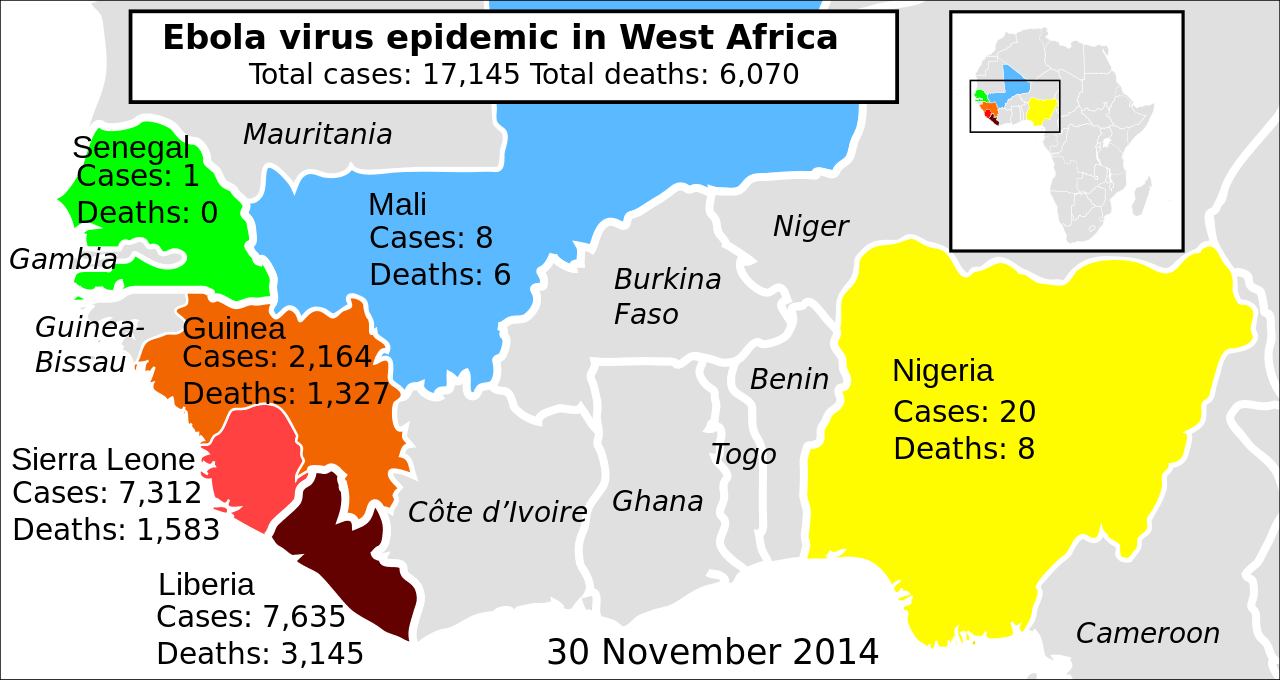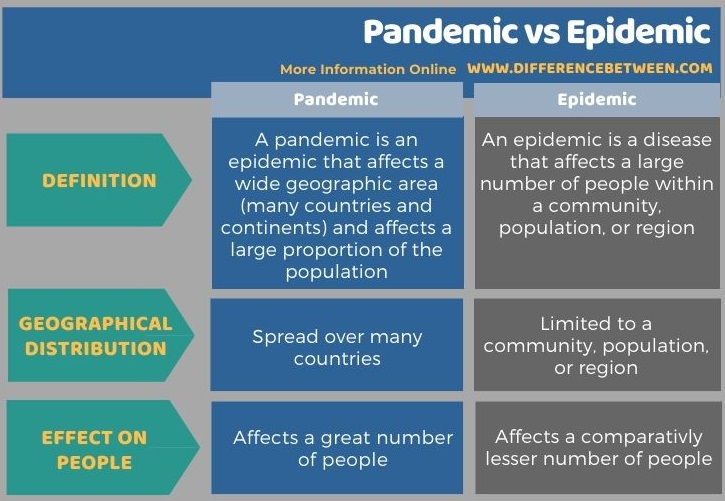Difference Between Pandemic and Epidemic
The key difference between pandemic and epidemic is their magnitude of spread. Epidemic is a disease that spreads rapidly, affecting many individuals at the same time, while pandemic is an epidemic that affects a wide geographic area (many countries and continents) and affects a large proportion of the population.
In the current world where Coronavirus is making headlines, knowing the difference between pandemic and epidemic is very important. Epidemics and pandemics are infectious diseases that spread over a large number of people. Though both these words seem to be the same, there is a difference between pandemic and epidemic.
CONTENTS
1. Overview and Key Difference
2. What is an Epidemic
3. What is a Pandemic
4. Side by Side Comparison – Pandemic vs Epidemic in Tabular Form
5. Summary
What is an Epidemic?
In layman terms, epidemic diseases can be termed as an infection that is found in a number of people at the same time. It is usually defined as a transmissible disease that affects a large number of people within a community, population, or region. When compared to a pandemic, the number of people infected will be comparatively less. A disease could be anything related to illness, body pain, fever, etc. Measles, malaria, cholera outbreaks, SARS (2003) and dengue fever are some examples of epidemic diseases.
Epidemic diseases are contagious diseases spread by partial or direct contact with the infected. It could be through water and food, sneeze, cough, saliva, etc. Good hygiene can help to keep away from at least some of these diseases. Most epidemic diseases have preventive vaccines that will improve the immunity of one’s body.
People often use term epidemic broadly to describe any problem that has grown out of control. During an epidemic, the disease is actively spreading. The two words epidemic and outbreak also have often been used interchangeably, but an outbreak is usually restricted to smaller events, while epidemic has a larger spread.
What is a Pandemic?
When the number of people affected by a disease is not limited to a locality, spreading across countries and continents, we call that disease a pandemic. A relatively huge population is affected by a pandemic. If an epidemic disease is given proper attention, it is possible to prevent it from escalating to a pandemic. However, some disease like COVID 19 have no acute treatment method or no vaccine; in such cases, it is very difficult to prevent its spread. HIV/AIDS, Bubonic plague, COVID-19, cholera are some examples of pandemic diseases.

The World Health Organization has identified a pandemic alert system that has six phases. Phase 1 indicates a low-risk virus, while phase 6 indicates a full-blown out pandemic.
Phase 1 – A virus in animals has caused no reported cases of infections in humans.
Phase 2 – A virus circulating in animals has caused infection in humans. This is considered as a specific potential pandemic threat.
Phase 3 – There are sporadic cases or small clusters of disease in people. There is no human to human transmission broad enough to cause community-level outbreaks.
Phase 4 – The disease is spreading from human to human with outbreaks at the community level.
Phase 5 – The disease is spreading between humans in two or more countries in a WHO region.
Phase 6 – In addition to the region identified in phase 5, there are community-level outbreaks in at least one country in another WHO region.
What is the Difference Between Pandemic and Epidemic?
A pandemic is an epidemic that affects a wide geographic area (many countries and continents) and affects a large proportion of the population. In contrast, an epidemic is a disease that affects a large number of people within a community, population, or region. While an epidemic is limited to a community, population, or region, a pandemic is spread over many countries. Therefore, when compared to a pandemic, the number of people affected in an epidemic is relatively lower.
The difference between pandemic and epidemic actually depends on the magnitude of their spread, not on the severity of the disease. In fact, the same disease can be identified as both a pandemic and epidemic in different situations. For example, there have been seven cholera pandemic outbreaks after 1816. The other outbreaks of cholera have not reached the magnitude of pandemic.

Summary – Pandemic vs Epidemic
Epidemic is an outbreak of a contagious disease that spreads rapidly and extensively and affecting many individuals simultaneously in an area or a population. Pandemic is an epidemic spread over a wide geographic area and affecting a large proportion of the population. Therefore, the key difference between pandemic and epidemic is in the magnitude of their spread.
Reference:
1. “Pandemics: Definition, Prevention, and Preparation.” WebMD, 2 Apr. 2020, Available here. 2. “Epidemic.” Wikipedia, Wikimedia Foundation, 5 May 2020, Available here.Image Courtesy:
1. “2014 ebola virus epidemic in West Africa” By Mikael Häggström. Also updated by BrianGroen. Esperanto version included in separate layer by Piet-c. – Own work (CC0) via Commons Wikimedia
2. “Coronavirus disease covid-2019, coronavirus, corona, covid-19, 2019-ncov, 3d render, danger, disease, epidemic, flu, health” (CC0) via Piksit
ncG1vNJzZmivp6x7pbXFn5yrnZ6YsqOx07CcnqZemLyue8OinZ%2Bdopq7pLGMm5ytr5Wau268wKebnqWZmHqiusNmnKmhlJq6qq%2BO